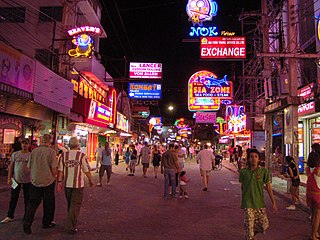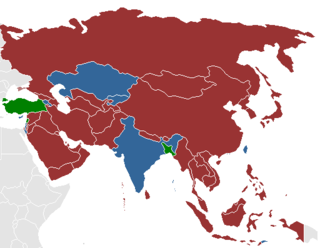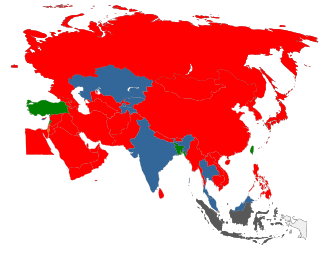Related Research Articles

Prostitution in Thailand is illegal. However, due to police corruption and an economic reliance on prostitution dating back to the Vietnam War, it remains a significant presence in the country. It results from poverty, low levels of education and a lack of employment in rural areas. Prostitutes mostly come from the northeastern (Isan) region of Thailand, from ethnic minorities or from neighbouring countries, especially Cambodia, Myanmar, and Laos. In 2019, UNAIDS estimated the total population of sex workers in Thailand to be 43,000.
Svay Pak is an urban commune of overseas Vietnamese in Cambodia, north of Phnom Penh. The commune has been renowned as a destination for adult and child prostitution, and while the latter has been cracked down upon, its prevalence as of 2017 was disputed.

Somaly Mam is a Cambodian anti-trafficking advocate who focuses primarily on sex trafficking. From 1996 to 2014, Mam was involved in campaigns against sex trafficking. She set up the Somaly Mam Foundation, raised money, appeared on major television programs, and spoke at many international events.

Prostitution is legal in India, but a number of related activities including soliciting, kerb crawling, owning or managing a brothel, prostitution in a hotel, child prostitution, pimping and pandering are illegal. There are, however, many brothels illegally operating in Indian cities including Mumbai, Delhi, Kolkata, Pune, and Nagpur, among others. UNAIDS estimate there were 657,829 prostitutes in the country as of 2016. Other unofficial estimates have calculated India has roughly 400,000 prostitutes. India is widely regarded as having one of the world's largest commercial sex industry. It has emerged as a global hub of sex tourism, attracting sex tourists from wealthy countries. The sex industry in India is a multi-billion dollar one, and one of the fastest growing.

The legality of prostitution in Asia varies by country. There is often a significant difference in Asia between prostitution laws and the practice of prostitution. In 2011, the Asian Commission on AIDS estimated there were 10 million sex workers in Asia and 75 million male customers.
Prostitution in Myanmar is illegal, but widespread. Prostitution is a major social issue that particularly affects women and children. UNAIDS estimate there to be 66,000 prostitutes in the country.
Prostitution in Guatemala is legal but procuring is prohibited. There is an offence of “aggravated procuring” where a minor is involved. Keeping a brothel is not prohibited.
Prostitution in South Africa is illegal for both buying and selling sex, as well as related activities such as brothel keeping and pimping. However, it remains widespread. Law enforcement is poor.
Prostitution in Ecuador is legal and regulated, as long as the prostitute is over the age of 18, registered, and works from a licensed brothel. Prostitution is widespread throughout the country. Many brothels and prostitutes operate outside the regulatory system and the regulations have been less strictly enforced in recent years. 25,000 prostitutes were registered in the year 2000. In 2007 it was estimated that 70% of the prostitutes in the country were from Colombia. The country attracts Colombian prostitutes as the currency is the US$ rather than the unstable Colombian peso. UNAIDS estimate there to be 35,000 prostitutes in the country.
Prostitution in Costa Rica is legal. Costa Rica's legal system is based on Roman law rather than common law, and so for prostitution to be illegal it would have to be explicitly stated as such in a penal code, and it is not. Nevertheless, many of the activities surrounding it are illegal, as the law forbids promoting or facilitating the prostitution of another, and therefore pimping, brothels, or prostitution rings are illegal. Prostitution is common and is practiced openly throughout the country, particularly in popular tourism destinations.

Prostitution is legal and regulated in Bangladesh. Prostitutes must register and state an affidavit stating that they are entering prostitution of their own free choice and that they are unable to find any other work. Bangladeshi prostitutes often suffer poor social conditions and are frequently socially degraded.
Prostitution in El Salvador is not prohibited by national law, but may be prohibited by local municipal ordinances. Municipal ordinances may also prohibit the purchase of sexual services. Related activities such as facilitating, promoting or giving incentives to a person to work as a prostitute (pimping) are illegal. The prostitution of children is also illegal. Brothel ownership, however, is legal. There are no specific laws against human trafficking, but any criminal offence that includes ‘commerce in women or children’ requires sentencing to be increased by 30%.

Cambodia is a source, transit, and destination country for human trafficking. The traffickers are reportedly organized crime syndicates, parents, relatives, friends, intimate partners, and neighbors. Despite human trafficking being a crime in Cambodia, the country has a significant child sex tourism problem; some children are sold by their parents, while others are lured by what they think are legitimate job offers like waitressing, but then are forced into prostitution. Children are often held captive, beaten, and starved to force them into prostitution.

Prostitution in Vietnam is illegal and considered a serious crime. Nonetheless, Vietnam's Ministry of Labour, Invalids and Social Affairs (MOLISA) has estimated that there were 71,936 prostitutes in the country in 2013. Other estimates puts the number at up to 200,000.
Prostitution in Indonesia is legally considered a "crime against decency/morality", although it is widely practiced, tolerated and even regulated in some areas. Some women are financially motivated to become prostitutes, while others may be forced by friends, relatives or strangers. Traditionally, they have met with customers in entertainment venues or special prostitution complexes, or lokalisasi (localization). However, recently internet forums and Facebook have been used to facilitate prostitute-client relations. In recent years, child sex tourism has become an issue at the resort islands of Batam and Bali.

Prostitution laws varies widely from country to country, and between jurisdictions within a country. At one extreme, prostitution or sex work is legal in some places and regarded as a profession, while at the other extreme, it is considered a severe crime punishable by death in some other places. A variety of different legal models exist around the world, including total bans, bans that only target the customer, and laws permitting prostitution but prohibiting organized groups, an example being brothels.
Prostitution in Namibia is legal and a highly prevalent common practice. Related activities such as solicitation, procuring and being involved in the running of a brothel are illegal. A World Bank study estimated there were about 11,000 prostitutes in Namibia.
Prostitution in Eritrea is legal and regulated. Official figures state there are around 2,000 prostitutes in the country, who are not allowed to operate near schools, hospitals, and churches. According to the 2009 Human Rights Reports, security forces occasionally follow women engaged in prostitution and arrest those who had spent the night with a foreigner. Some women enter prostitution due to poverty. Prostitutes are known locally as "shermuta" in Arabic, or "mnzerma" and "me'amn" in Tigrinya.

Prostitution in Laos is regarded as a criminal activity and can be subject to severe prosecution. It is much less common than in neighbouring Thailand. Soliciting for prostitution takes place mainly in the city's bars and clubs, although street prostitution also takes place. The visibility of prostitution in Laos belies the practice's illegality. As of 2016, UNAIDS estimates there to be 13,400 prostitutes in the country.
Sex trafficking in China is human trafficking for the purpose of sexual exploitation and slavery that occurs in the People's Republic of China. It is a country of origin, destination, and transit for sexually trafficked persons.
References
- 1 2 "Law on Suppression of Human Trafficking and Sexual Exploitation". Scribd. 15 February 2008.
- ↑ "Cambodia: Sex Workers Face Unlawful Arrests and Detention". Human Rights Watch. 21 July 2010. Archived from the original on 4 July 2011. Retrieved 29 April 2016.
- 1 2 3 Off the Streets: Arbitrary Detention and Other Abuses against Sex Workers in Cambodia (PDF). Human Rights Watch (Report). July 2010.
- ↑ Paula Stromberg (4 March 2012). "Sex work in Cambodia". DailyXtra.
- ↑ "Sex workers: Population size estimate - Number, 2016". www.aidsinfoonline.org. UNAIDS. Archived from the original on 4 April 2019. Retrieved 21 July 2018.
- ↑ Vu, J.B. (3 November 2010). "Thousands of Vietnamese women and children sold as "sex slaves"". AsiaNews.
- ↑ "Human Trafficking & Modern-day Slavery Socialist Republic of Vietnam". Human Trafficking, Modern-day Slavery, Forced Labor & Debt... GVnet.
- ↑ Nguyen Dinh Thang; Vu Quoc Dung; Pastor Truong Tri Hien; Nguyen Cao Quyen; Nguyen Quoc Khai; Ngo Thi Hie (May 2008). Vietnam Country Report Background Information and Recommendations (PDF) (Report). Vietnam Study Group. Archived from the original (PDF) on 11 September 2011.
- 1 2 Milton Osborne, Sihanouk, Prince of Light, Prince of Darkness. Silkworm 1994
- 1 2 3 "CAMBODIA: prostitution and sex trafficking: a growing threat to the human rights of women and children in Cambodia". Human Rights Solidarity (Vol. 12). 6 (4). 4 November 1996. Archived from the original on 18 September 2008.
- ↑ Soizick Crochet, Le Cambodge, Karthala, Paris 1997, ISBN 2-86537-722-9
- ↑ Ditmore, Melissa Hope (2006). Encyclopedia of Prostitution and Sex Work. Greenwood Press. ISBN 9780313329708 – via google.ca.
- ↑ Gittings, John (16 November 2000). "The tragic tale of the Cambodian child prostitutes". Guardian. London. Retrieved 1 March 2008.
- ↑ Harding, Andrew (11 June 2005). "Trapping Cambodia's sex tourists". BBC. Retrieved 1 March 2008.
- 1 2 "Dateline goes undercover with a human rights group to expose sex trafficking in Cambodia". NBC News. Retrieved 1 March 2008.
- ↑ "Cambodia gets tough on child sex trade". The Christian Science Monitor. Retrieved 1 March 2008.
- ↑ "Asian Child Rights". Asian Human Rights Commission. Archived from the original on 30 March 2010. Retrieved 18 May 2010.
- ↑ "The US agents tracking down sex tourists in Cambodia". BBC News. 30 January 2011.
- ↑ Busuttil, Fanny (15 March 2012). "Children of Viet Nam". Humanium.
- ↑ "Trafficking of Vietnamese Women Expands Across Region". Bangkok: Reuters. 18 May 2016.
- ↑ "Inside k11, Phnom Penh's notorious child brothel". nypress. 11 November 2014.
- ↑ Hume, Tim; Cohen, Lisa; Sorvino, Mira. "The women who sold their daughters into sex slavery". Phnom Penh, Cambodia. CNN.
- ↑ Wood, Richard; Sam, Rith (30 July 2004). "Study looks at 'bauk' - gang-rape of prostitutes". Phnom Penh Post. Retrieved 1 April 2018.
- ↑ Aglionby, John (26 July 2003). "Sex workers helpless as young men 'bond' in gang rape outings". The Guardian. Retrieved 1 April 2018.
- ↑ Ditmore, Melissa Hope (11 March 2014). ""Caught Between the Tiger and the Crocodile": Cambodian Sex Workers' Experiences of Structural and Physical Violence". Studies in Gender and Sexuality. 15: 22–31. doi:10.1080/15240657.2014.877726. S2CID 144716733.
- ↑ "Gang Rape Has Become the Sport of the Young generation". Archived from the original on 2 March 2011. Retrieved 16 February 2011.
- ↑ Hoenig, Henry (26 October 2003). "France cracking the whip on sex / Liberated nation turns moralistic". The San Francisco Chronicle. Archived from the original on 16 July 2011.
- ↑ "Document" . Retrieved 31 December 2010.
- ↑ Couture, Marie-Claude; Sansothy, Neth; Sapphon, Vonthanak; Phal, Serey; Sichan, Keo; Stein, Ellen; Evans, Jennifer; Maher, Lisa; Kaldor, John; Vun, Mean Chhi; Page, Kimberly (January 2011). "Couture et al. Young women engaged in sex work in Phnom Penh, HIV, STI, stimulants. Challenges to HIV prevention and risk. STD 2011". Sexually Transmitted Diseases. 38 (1): 33–9. doi:10.1097/OLQ.0b013e3182000e47. PMC 3729941 . PMID 21085056.
- ↑ "CNN.com - U.S. raps Cambodia over sex trade". CNN. 14 December 2004.
- ↑ "Cambodian Girls Driven to Prostitution". Radio Free Asia.
- ↑ "Cambodia". U.S. Department of State.
- 1 2 Willem van Schendel; Lenore Lyons; Michele Ford (2012). Labour Migration and Human Trafficking in Southeast Asia: Critical Perspectives. Routledge. ISBN 978-0-415-66563-6.
- ↑ Daniel Pye. "US was on to Somaly Mam". The Phnom Penh Post.
- ↑ "Officials Hand Donations to Somaly Mam's NGO". The Cambodia Daily. 31 December 2014. Archived from the original on 13 December 2018. Retrieved 10 November 2015.
- ↑ Larissa Sandy (27 August 2014). Women and Sex Work in Cambodia: Blood, Sweat and Tears. Routledge. ISBN 978-1-317-64930-4.
- ↑ Adam Taylor (29 May 2014). "Why would Somaly Mam quit her own sex-trafficking foundation?". Washington Post.
- ↑ "Is buying sex a better way to help Cambodian women than buying a T-shirt?". Slate Magazine. 19 May 2011.
- ↑ "The High Cost of Cheap Clothes". VICE. 17 October 2014.
- ↑ "The Walkabout Is Cambodia's Sleaziest Bar". Vice. 25 December 2014.
There are the geriatric sex tourists in white socks and sandals whose rheumy eyes go laser sharp when they hone in[ sic ] on the desperate, teenage hookers whose only other option is working in a sweatshop for $2.50 a day.
- 1 2 3 4 "Cambodia 2018 Trafficking in Persons Report". U.S. Department of State. Archived from the original on 26 July 2018. Retrieved 26 July 2018.
 This article incorporates text from this source, which is in the public domain .
This article incorporates text from this source, which is in the public domain . - ↑ Kongkea, Buth Reaksmey (19 January 2022). "Human trafficker denies selling Cambodian women to brothels in Malaysia". Khmer Times.